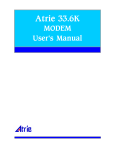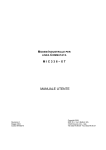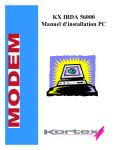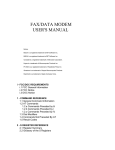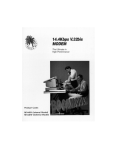Download Data-Linc Group DLM4100 User guide
Transcript
INDUSTRIAL DATA COMMUNICATIONS USER GUIDE DLM4100 Compact Dial-Up Modem It is essential that all instructions contained in the User Guide are followed precisely to ensure proper operation of equipment. Product User Guide DATA-LINC GROUP PN 161-09977-001B DLM4100 User’s Manual Operating Instructions The DLM4100 is a compact dial-up modem designed and manufactured to operate in full industrial applications. It is powered with an input voltage range of +8V to +15VDC. A 120VAC to unregulated 12VDC wall transformer power supply has been provided (24VDC versions also available). The operating temperature range of this device is 0° to 70° C. The (ET) Extended Temperature model is rated at -40° to +85° C. Any device connected to the modem must be set for a 10-bit word such as: Data Bits Stop Bits Start Bits 8 1 1 7 1 1 7 2 1 Parity None Even/Odd None Connections Cable connections are all made on one end of the unit. The DB-9 female (see pinout below) on the left is for the RS-232 data. Note: RS-485 and RS-422 models are also available The supplied wall transformer plugs into the barrel jack for supplying power to the unit. For alternate power methods, see barrel jack pinout below. The RJ-11 jack on the right is the telephone line connection. Only the center two lines are used. DB-9 for the RS-232 data port. The port is setup as a DCE device and the pins are: DB-9 Female Description Pin 1 Carrier Detect Pin 2 Data Out of modem RS-232 port Pin 3 Data Into modem RS-232 port Pin 4 N/C Pin 5 Ground Pin 6 N/C Pin 7 N/C Pin 8 N/C Pin 9 N/C The 12 VDC power jack plug for input power. 12VDC (P-5 Barrel Jack) Center Pin Outer Ring P/N 161-09977-001B +8 to 15VDC in Ground 2 DLM4100 User’s Manual Indicators There are four LED’s displayed out the front panel for status and diagnostics they are as follows: (P) Power Red On indicates that the board is receiving power (C) Carrier Amber On indicates that a connection has been made to another DLM4100 ( I ) Data In Yellow On indicates that data is flowing into the serial port (O) Data Out Green On indicates that data is flowing out to the serial port Since the DLM4100 has been pre-configured at the factory for typical PLC to PC use, the only command strings required are for dialing and hanging up. The command instruction to be entered in either PC or PLC programmed for dial-up operation are listed below: Dial String: ATDTx Command Mode (escape sequence): +++ Hang up: ATH0 Note: Do not use any initialization string at all when commanding the modem to dial. Any command other than the ATDT followed by the number being dialed can change the pre-configuration of the DLM4100 and make it inoperative for PLC communications. Specifications Input Voltage Current Consumption Ring Voltage Detected Ring Frequency Detected Telephone Loop Current Data Transmit Level DTMF Transmit Level Operating Temperature Range Enclosure Material Enclosure Dimension Weight +8 to 15 VDC Max 260mA 38 to 150 RMS 15.3 to 68 Hz 20 to 100mA -12 to –9.0 dBm -2.5 dBm Avg. over 3 second interval 0° C to 70° C Standard Model -40° C to 85° C Extended Temperature Model 18 gauge steel 9.0” x 5.0” x 1.5” over mounting flanges 1.68 lb. .76 kg. Note: The following pages are the AT Commands, Modem Registers, and Result codes for your reference. In pre-configured systems from Data-Linc Group these values should not be changed. P/N 161-09977-001B 3 DLM4100 User’s Manual AT Commands A- Answer Command – ATA forces the modem to immediately go off-hook and begin transmitting the answer tone sequence. Bn- Select Communications Standard – ATBn selects the modulation scheme used for connections below 2400 bits per second. n=0 Selects CCITT standards n=1 Selects Bell standards D- Dial Command – Below are the characters accepted in a dialing command. 0-9, #,* = Dialing Digits L = Re-dial last number P = Pulse dial T = Tone dial S=n = Dial stored number W = Wait for dial tone ^ = Toggles state of calling tone , = Pause for the duration of S8 @ = Wait for silence ! = Switch hook flash ; = Return to the command state En- Command Echo – ATEn determines whether commands will be echoed back to the host. n=0 Do not echo commands n=1 Enable command echo Hn – Switch Hook Control – ATHn opens and closes the modem’s hook switch. n=0 Switch hook relay opens n=1 Switch hook relay closes Ln- Speaker Volume – ATLn Sets the amplitude of the modem’s audio output n=0 Lowest speaker volume n=1 Low speaker volume n=2 Speaker remains on n=3 Speaker off during dialing, on until carrier Mn- Speaker Activity – ATMn determines when the modem’s audio output is active. n=0 Speaker off n=1 Speaker on until carrier received n=2 Speaker remains on n=3 Speaker off during dialing, on until carrier P/N 161-09977-001B 4 DLM4100 User’s Manual On- On Line – ATOn switches the modem from the command mode to the data mode. n=0 Return on-line with no retrain n=1 Initiate retrain returning on-line Qn- Reponses – ATQn determines if the modem will issue responses n=0 Send responses* n=1 No responses SR?- Interrogate Register – ATSr? request the current value in register Sr. SR=n- Set Register Value – ATsr=n sets the value of register Sr to n Vn- Result Codes – ATVn sets the modem to issue numeric or full word result codes n=0 Numeric result codes n=1 English word result codes Wn- Connect Message Rate – ATWn determines whether the data rate reported in the Connect response is the host date rate, the link data rate or whether both are provided along with the error control and data compression protocols negotiated. n=0 Send “Connect” at DTE rate n=1 Report line speed, DTE speed and Link protocol n=2 “Connect” reports Link speed Xn- Result Code Set – ATXn selects which set of result codes the modem may send. n=0 Result codes 0 to 4 n=1 Result codes 0 to 5 and 10 n=2 Result codes 0 to 6 and 10 n=3 Result codes 0 to 5, 7 and 10 n=4 Full result codes* Zn- Reset – ATZn executes a soft reset to the modem and resets the modem configuration n=0 Reset to user profile 0 n=1 Reset to user profile 1 &Cn- DCD Operation – AT&Cn determines the operation of the DCD output. n=0 DCD is forced active n=1 DCD indicates a valid carrier P/N 161-09977-001B 5 DLM4100 User’s Manual &Dn- DTR – AT&Dn determines how the modem will respond to changes to DTR n=0 DTR is ignored by the modem n=1 Enter command mode if DTR revoked n=2 Disconnect if DTR revoked n=3 Soft reset when DTR revoked &Gn- Guard Tone – AT&Gn controls the guard tone produced by the modem n=0 Guard tone disabled n=1 Guard tone disabled n=2 1800 Hz guard tone &Kn- Flow Control – AT&Kn selects the flow control method used by the modem n=0 Disabled n=3 RTS/CTS n=4 XON/XOFF n=5 Transparent XON/XOFF n=6 RTS/CTS and XON/XOFF &Pn- Dial Pulse Make/break Ratio – AT&Pn determines the specific pulse dialing parameters used by the modem n=0 39/61% @ 10pps n=1 33/67% @ 10pps n=2 39/61% @ 20pps n=3 33/67% @ 20pps &Qn- Line Connection – AT&Qn determines if error control or data buffering are active on the link n=0 Direct mode (no data buffering) n=5 Use Error Correction n=6 Normal Mode (speed buffering) &Sn- DSR Operation – AT&Sn sets the operation of the DSR signal n=0 DSR always active n=1 DSR in accordance with V.25 &Tn- Test Modes – AT&Tn selects modem test modes n=0 Exit test mode n=1 Local analog loopback n=3 Initiate local digital loopback n=4 Respond to remote loop request n=5 Deny remote loop request n=6 Initiate a remote digital loopback n=7 Remote digital loopback with self-test n=8 Local analog loopback with self-test P/N 161-09977-001B 6 DLM4100 User’s Manual &Vn- View Configuration Profiles – AT&Vn permits the user to check on the modem’s current configuration n=0 View active profile & user profile 0 n=1 View active profile & user profile 1 &Wn- Store Active Profile – AT&Wn stores the current modem configuration in NVRAM. n=0 Store active profile as profile 0 n=1 Store active profile as profile 1 &Yn- Recall Stored Profile – AT&Yn sets the stored modem configuration to be used after a hard reset n=0 Recall profile 0 on power-up n=1 Recall profile 1 on power-up &Zn=x- Store telephone number “x” in memory location “n” %En- Line Quality Monitor/Auto Retrain – AT%En determines if the modem will monitor line quality during a connection and initiate a retrain if quality drops below acceptable levels. n=0 Disabled n=1 Enabled n=2 Line quality, fall back, fall forward %L- Read Received Signal Level – AT%L permits the user to read the magnitude of the receive signal in dBm %Q- Read Line Signal Quality – AT%Q permits the user to read the EQM value of the received signal \Bn- Transmit Break – AT\Bn selects the duration of the break signal sent Break=n x 100 msec. \Gn- Modem Port Flow Control – n=0 No modem port flow control n=1 XON/XOFF port flow control P/N 161-09977-001B 7 DLM4100 User’s Manual \Kn- Break Control – AT\Kn determines how the modem will handle a break signal. Break received from host with reliable link n=0 Enter on-line command mode; do not transmit break n=1 Purge buffers, immediately transmit break n=2 Same as n=0 n=3 Immediately send break n=4 Same as n=0 n=5 Send break in sequence with data Break received from host with direct link n=0 Immediately transmit break, then enter on-line command mode n=1 Immediately send break n=2 Enter command mode, but do not transmit break n=3 Same as n=1 n=4 Same as n=0 n=5 Same as n=1 Break received from modem with normal link n=0 Purge buffers, immediately send break to the host n=1 Same as n=0 n=2 Immediately send break to the host n=3 Same as n=2 n=4 Send break in sequence with data n=5 Same as n=2 Host initiates break on reliable link n=0 Purge buffers and immediately transmit break n=1 Same as n=0 n=2 Immediately transmit break n=3 Same as n=1 n=4 Transmit break in sequence with data n=5 Same as n=4 \Nn- Error Control Selection -AT\Nn determines how the modem will handle error control negotiations n=0 Normal mode, no error correction n=1 Direct mode, no buffering, no error correction n=2 Reliable mode, error correction required n=3 V.42 Auto-reliable mode, accept either an error controlled or non-error controlled link n=4 V.42 Reliable mode, LAPM required n=5 MNP required -Kn- MNP Extended Services – AT-Kn determines how the modem handles MNP10 n=0 No LAPM to MNP10 conversion n=1 LAPM to MNP10 conversion n=2 LAPM to MNP10 conversion but no MNP extended service during V.42 LAPM answer mode detect P/N 161-09977-001B 8 DLM4100 User’s Manual +MS- Select Modulation – AT+MS sets the modulation and available data rates in the format shown below AT+MS= a, b, c, d, e, f <CR> a=Modulation type B103- Bell 103 (300 BPS) B212- Bell 212 (1200 BPS) V21- V.21(300 BPS) V22- V.22 (1200 BPS) V22B- V.22bis (1200 or 2400 BPS) V23- V.23 (1200 Tx/ 75 RX or 75 Tx/ 1200 Rx) V32- V.32 (4800 or 9600 BPS) V32B- V.32bis (4800 to 14400 BPS) V34- V.34bis (16800 to 33600 BPS) b= Auto detection 0- Automatic Negotiation Disabled 1- Automatic Negotiation Enabled c= Minimum receive Data Rate (300 to 33600 BPS) d= Maximum receive Data Rate (300 to 33600 BPS) e= Minimum transmit Data Rate (300 to 33600 BPS) f= Maximum transmit Data Rate (300 to 33600 BPS) Modem Registers S0 Answer on nth Ring: S0 sets the modem to automatically answer on the nth ring. Setting S0 to 0 disables automatic answer. Range: 0 to 255 Units: Rings Default: 0 S1 Ring Count: S1 is a read-only register showing the number of rings detected. If a ring is not detected within 8 seconds, S1 reset to zero. Range: 0 to 255 Units: Rings Default: 0 S2 Escape Character: S2 determines the ASCII escape character. Values of 0-127 select valid ASCII escape characters; values from 128-255 disable the escape sequence. Range: 0 to 255 Units: ASCII Character Default: 43 P/N 161-09977-001B 9 DLM4100 User’s Manual S3 Carriage Return Character: S3 determines the ASCII character to serve as a carriage return to terminate commands and modem responses. Range: 0 to 127 Units: ASCII Character Default: 13 (carriage return) S4 line Feed Character: S4 sets the ASCII character to act as a line feed character in modem responses. Range: 0 to 127 Units: ASCII Character Default 10 (line feed) S5 Back Space Character: S5 defines the ASCII character used as a back space to edit the command line. Range: 0 to 32 Units: ASCII Character Default: 8 (back space) S6 Dial Tone Wait Time: S6 determines how long the modem waits for dial tone before dialing begins. The dial tone wait time cannot be set to less than two seconds. Range: 2 to 255 Units: Seconds Default: 2 S7 Wait for Carrier after Dialing: S7 determines how long the modem waits for a valid carrier signal after dialing is completed. Range: 1 to 255 Units: Seconds Defaults: 50 S8 Comma Pause Time: S8 defines the duration of the pause initiated by a comma in the dialing string. The pause is generally used when waiting for a second dial tone. Range: 1 to 255 Units: Seconds Default: 50 S9 Reserved P/N 161-09977-001B 10 DLM4100 User’s Manual S10 Carrier Off Disconnect Delay: S10 selects how long carrier must be lost before the modem disconnects. Note: if S10 is smaller than the value of S9, the modem will not automatically disconnect on loss of carrier. Range: 1 to 255 Units: 0.1 Seconds Default: 14 S11 Tone Dialing Speed: S10 sets the duration and spacing of the dialing tones. S11 does not affect the pulse dialing rate. Range: 50 to 255 Units: 1 Millisecond Default: 95 S12 Escape Code Guard Timer: S12 sets the escape sequence guard timer. If characters are received before or after the escape sequence, within the guard timer, the modem aborts the escape attempt and remains in data mode. Range: 0 to 255 Units: 0.02 Seconds Default: 50 S14 General Bit-Mapped Options: S14 reflects the state of several “AT” commands. Bit 0,4,6 not used Bit 1 Bit 2 Bit 3 Bit 5 Bit 7 0=Echo Disabled (ATE0) 1=Echo Active (ATE1) 0=Send result codes (ATQ0) 1=No result codes (ATQ 1) 0=Numeric result codes (ATV0) 1=Full word result codes (ATV1) 0=Tone dialing selected (T) 1=Pulse dialing selected (P) 0=Answer 1=Originate S16 Test Status: S16 shows the modem test status. Bit 0 0=No local analog loopback 1=Local ALB active Bit 2-7 not used P/N 161-09977-001B 11 DLM4100 User’s Manual S21 General Bit-Mapped Options: S21 reflects the state of several “AT” commands. Bit 0-2 Not used Bit 3-4 0=DTR ignored (&D0) 1=Enter command mode on DTR off (&D1) 2=Disconnect on DTR off (&D2) 3=Reset on DTR off (&D3) Bit 5 0=DCD always active (&C0) 1=DCD on with carrier (&C1) Bit 6 0=DSR always active (&C0) 1=DSR on when modem ready (&C1) Bit 7 0=No disconnect on space (ATY0) 1=Disconnect on space (ATY1) S22 General Bit-Mapped Options: S22 reflects the stat of several “AT” commands. Bit 0-1 0=Low speaker volume (ATL0) 1=Low speaker volume (ATL1) 2=Moderate speaker volume (ATL2) 3=High speaker volume (ATL3) Bit 2-3 0=Speaker off (ATM0) 1=Speaker off with carrier (ATM1) 2=Speaker always on (ATM2) 3=Speaker on during handshake (ATM3) Bit 4-6 0=Basic result codes (ATX0) 4=Connect speed result codes (ATX1) 5=No blind dial (ATX2) 6=Busy detection (ATX3) 7=Full result codes (ATX4) Bit 7 Not used S23 General Bit-Mapped Options: S23 reflects the state of several “AT” commands. Bit 0 0=Remote DLB disabled (AT&T5) 1=Remote DLB allowed (AT&T4) Bit 1-3 0=Host interface at 300 BPS 1=Host interface at 600 BPS 2=Host interface at 1200 BPS 3=Host interface at 2400 BPS 4=Host interface at 4800 BPS 5=Host interface at 9600 BPS 6=Host interface at 19200 BPS 7=Host I/F at 38,400 BPS or higher Bit 4-5 0=Even parity in use 1=Not in use 2=Odd parity in use 3=No parity in use Bit 6-7 0=No guard tone (AT&G0) 1=No guard tone (AT&G1) 2=1800 Hz guard tone (AT&G2) 3=Not used P/N 161-09977-001B 12 DLM4100 User’s Manual S24 Sleep Mode Timer: S24 sets the length of time in seconds that the modem must be idle before entering the low power, sleep mode. When S24 is set to 0, sleep mode is disabled. Range:0 to 255 Units: seconds Default: 0 S27 Pulse Dialing Bit-Mapped Options: S27 reflects the state of several “AT” commands. Bit 0 0 1 0 1 0 0 1 3 0=Normal mode (AT&Q0) 1=Error control enabled (AT&Q5) 1=Direct mode (AT&Q6) Bit 2, 4- 5, 7 Not used Bit 6 0=CCITT Protocols (ATB0) 1=Bell Protocols (ATB1) S28 Pulse Dialing Bit-Mapped Options: S28 stores the modem’s pulse dialing configuration. Bit 0-2, 5-7 Not used Bit 3-4 0=Make/Break ratio 39%/61%; 10 pulses per second (AT&P0) 1=Make/Break ratio 33%/67%; 10 pulses per second (AT&P1) 2=Make/Break ratio 39%/61%; 20 pulses per second (AT&P2) 3=Make/Break ratio 33%/67%; 20 pulses per second ( AT&P3) S29 Hook Flash Timer: S29 determines the length of time the modem closes its off-hook relay on receipt of the “I” dial modifier to simulate a switch hook flash. Range: 0 to 255 Units: 10 Milliseconds Default: 70 S30 Disconnect on Inactivity Timer: S30 sets the period the modem is idle before it disconnects. A 0 disables the inactivity timer. Range: 0 to 255 Units: 10 Seconds Default: 0 S31 General Bit-Mapped Options: S31 stores the status of various AT commands. Bit 0 0=No single-line connect messages (AT\V0) 1=Single-line connect messages Bit 1 0=No auto mode detection (ATN0) 1=Auto mode detection active (ATN1) Bit 2-3 0=Report host speed (ATW0) 1=Report all parameters (ATW1) 2=Report modem speed only (ATW2) Bit 4-7 Not used S32 XON Character: S32 determines the ASCII character to be sent as XON for in-band flow control. Range: 0 to 255 Units: ASCII Character Default: 11 (VT) P/N 161-09977-001B 13 DLM4100 User’s Manual S33 XOFF Character: S33 determines the ASCII character to be recognized as XOFF for in-band flow control. Range: 0 to 255 Units: ASCII Character Default: 19 (DC3) S36 LAPM Failure: S36 instructs the modem what to do if the error control negotiations fail. Bit 0-2 0=Modem disconnects 1=Establish direct connection 3=Establish normal connection 4=Disconnect if MNP handshake fails 5=Establish direct connection if MNP handshake fails 7=Establish normal connection if MNP handshake fails Bit 3-7 Not used S38 Forced Disconnect Timer: S38 sets the delay between receipt of the command to disconnect and the actual opening of the switch hook. If S38 is set to 255 the modem disconnects only after its buffers are empty. Range: 0 to 255 Units: 1 Second Default: 20 S39 Flow Control Bit-Mapped Options: S39 shows the modem’s flow control status, AT&K. Bit 0-2 0=Flow control disabled 3=Hardware flow control, RTS/CTS 4=In-band flow control XON/XOFF 5=Transparent in-band flow control 6=Both hardware and in-band flow control Bit 3-7 Not used S40 MNP Bit-Mapped Option: S40 shows the status of the modem’s MNP commands. Bit 0-1 0=No LAPM to MNP10 conversion (AT-K0) 1=Enable LAPM to MNP10 conversion (AT-K1) 2=Enable LAPM to MNP10 conversion, except for LAPM answer mode (AT-K1) Bit 2 Not used Bit 3-5 0=AT\K0 break handling selected 1=AT\K1 break handling selected 2=AT\K2 break handling selected 3=AT\K3 break handling selected 4=AT\K4 break handling selected 5=AT/K5 break handling selected Bit 6-7 0=MNP block size 64 characters 1=MNP block size 128 characters 2=MNP block size 192 characters 3=MNP block size 256 characters P/N 161-09977-001B 14 DLM4100 User’s Manual S41 General Bit-Mapped Options: S41 stores the condition of various “AT” commands. Bit 0-1 0=No data compression (AT%C0) 1=MNP5 data compression (AT&C1) 2=V.42bis data compression (AT&C2) 3=Either MNP5 or V.42bis data compression (AT&C3) Bit 2 6 0 0=No fall back/forward (AT%E0) 1 0=Retrain enabled (AT%E1) 0 1=Fall back/forward enabled (AT%E2) Bit 3-5,7 Not used S46 Data Compression Control: S46 selects whether or not he modem will support data compression with error control. S46=136 No data compression S46= 138 Data compression selected Default: 138 S48 V.42 Negotiations: S48 determines the modem’s V.42 negotiation process. S48=0 Proceed with LAPM S48=7 Negotiate per V.42 S48=128 Assume LAPM failure Default: 7 S86 Fall Failure Code: S86 shows why the last “NO CARRIER” response was issued. S86=0 Normal disconnect S86=4 Loss of carrier S86=5 V.42 negotiation failure S86=9 Modem handshake failure S86=12 disconnect initiated by remote modem S86=13 No response after 10 retries S86=14 Protocol violation S95 Extended Result Codes: S95 permits the user to customize the extended result codes. Bit 0 Bit 1 Bit 2 Bit 3 Bit 4 Bit 5 Bit 6 Bit 7 Connect result code shows link speed Add /ARQ to connect response Add /VFC to carrier response Enable protocol response Not used Enable compression result code Not used Not used P/N 161-09977-001B 15 DLM4100 User’s Manual Result Code Digits 0 1 2 3 4 5 6 7 8 9 10 11 12 13 14 15 16 17 18 19 22 23 33 35 40 44 45 46 47 48 49 50 51 52 53 54 55 56 57 P/N 161-09977-001B Verbose OK CONNECT RING NO CARRIER ERROR CONNECT 1200 NO DIAL TONE BUSY NO ANSWER CONNECT 600 CONNECT 2400 CONNECT 4800 CONNECT 9600 CONNECT 7200 CONNECT 12000 CONNECT 14400 CONNECT 19200 CONNECT 38400 CONNECT 57600 CONNECT 115200 CONNECT 75TX/1200RX CONNECT 1200TX/75RX FAX DATA +MRR: 300 +MRR: 1200/75 +MRR: 75/1200 +MRR: 1200 +MRR: 2400 +MRR: 4800 +MRR: 7200 +MRR: 9600 +MRR: 12000 +MRR: 14400 +MRR: 16800 +MRR: 19200 +MRR: 21600 +MRR: 24000 +MRR: 26400 Description Successfully executed command line 300 BPS connection Ring signal detected Carrier not detected/lost Error in command line 1200 BPS connection No dial tone detected Busy signal detected 5 second silence not detected 600 BPS connection 2400 BPS connection 4800 BPS connection 9600 BPS connection 7200 BPS connection 12000 BPS connection 14400 BPS connection 19200 BPS connection 38400 BPS connection 57600 BPS connection 115200 BPS connection V.23 originate connection V.23 answer connection Fax connection Data connection in Fax mode 300 BPS carrier received V.23 reverse channel carrier received V.23 forward channel carrier received 1200 BPS carrier received 2400 BPS carrier received 4800 BPS carrier received 7200 BPS carrier received 9600 BPS carrier received 12000 BPS carrier received 14400 BPS carrier received 16800 BPS carrier received 19200 BPS carrier received 21600 BPS carrier received 24000 BPS carrier received 26400 BPS carrier received 16 DLM4100 User’s Manual 58 59 61 62 63 64 66 67 69 70 77 78 79 80 81 84 91 134 135 136 137 138 139 140 141 142 +F4 P/N 161-09977-001B +MRR: 28800 CONNECT 16800 CONNECT 216000 CONNECT 24000 CONNECT 26400 CONNECT 28800 +DR: ALT +DR: V42B +DR: NONE +ER: NONE +ER: LAPM +MRR: 31200 +MMR: 33600 +ER: ALT +ER: ALT CELLULAR CONNECT 33600 CONNECT 31200 +MCR: B103 +MCR: B212 +MCR: V21 +MCR: V22 +MCR: V22B +MCR: V23 +MCR: V32 +MCR: V32B +MCR: V34 +FCERROR 28800 BPS carrier received 16800 BPS connection 21600 BPS connection 24000 BPS connection 26400 BPS connection 28800 BPS connection MNP5 data compression V.42bis data compression No data compression No error correction LAPM error correction 31200 BPS connection 33600 BPS connection MNP error correction MNP10 error correction 33600 BPS connection 31200 BPS connection Bell 103 connection Bell 212A connection V.21 connection V.22 connection V.22bis connection V.23 connection V.32 connection V.32bis connection V.34 connection Fax carrier error 17 DLM4100 User’s Manual Technical Support Data-Linc Group maintains a fully trained staff of service personnel who are capable of providing complete product assistance. They can provide you with technical and application troubleshooting, spare parts and warranty assistance. Our technical staff is based in Redmond, Washington USA and may be reached at (425) 882-2206 or email [email protected]. Product Warranty Data-Linc Group warrants equipment of its own manufacture to be free from defects in material and workmanship for one year from date of shipment to original user. Data-Linc Group will replace or repair, at our option, any part found to be defective. The buyer must return any part claimed defective to Data-Linc Group, transportation prepaid. Return Material Authorization If a part needs to be sent to the factory for repair, contact Data-Linc Group’s corporate office and request a Return Material Authorization (RMA) number. The RMA number identifies the part and the owner and must be included with the part when shipped to the factory. Contact Information Corporate Office Data-Linc Group 3535 Factoria Blvd. SE Suite 100 Bellevue, WA 98006 USA Telephone: (425) 882-2206 Fax: (425) 867-0865 Email: [email protected] Web site: www.data-linc.com P/N 161-09977-001B 18



















